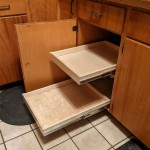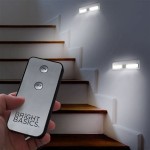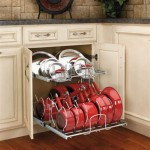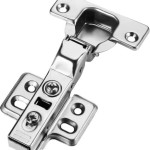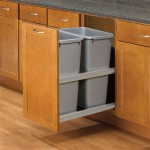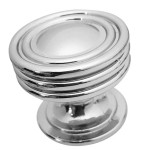Kitchen Cabinets With Glass Doors: Ideas and Design Considerations
Kitchen cabinets with glass doors offer a stylish and functional alternative to traditional solid-door cabinets. These cabinets introduce an element of visual openness, allowing homeowners to showcase their dinnerware, glassware, and decorative items while adding depth and dimension to the kitchen. Integrating glass-front cabinets requires careful planning and consideration of design principles to achieve a cohesive and aesthetically pleasing space.
The choice of glass, frame materials, and interior cabinet lighting are all essential factors that influence the overall look and feel of a kitchen with glass-front cabinets. Furthermore, the decision on what to display within the cabinets is crucial to maintaining a clean and organized visual aesthetic. This article will explore various ideas and design considerations for incorporating glass doors into kitchen cabinetry.
Enhanced Visual Space and Light
One of the primary benefits of using glass doors in kitchen cabinets is the expansion of visual space. Solid doors can create a feeling of confinement, particularly in smaller kitchens. Glass doors, conversely, allow the eye to travel through the cabinet, effectively extending the perceived boundaries of the room. This is particularly beneficial in galley kitchens or kitchens with limited natural light.
Glass also allows natural light and artificial light to penetrate the cabinet interior. This can brighten the entire kitchen space, especially in areas where overhead lighting may be insufficient. The reflective properties of glass further enhance this effect by bouncing light around the room, creating a brighter and more inviting atmosphere. Consider strategically placing glass-front cabinets in areas where they can maximize light reflection, such as above a sink or near a window.
Different types of glass can also impact the amount of light transmission and the level of visual clarity. Clear glass provides the highest transparency, allowing for unobstructed views of the cabinet contents. Frosted glass, on the other hand, diffuses light and obscures the contents, offering a more subtle and diffused look. Leaded glass or textured glass can add a decorative element while still allowing light to pass through.
Interior cabinet lighting can significantly enhance the visual impact of glass-front cabinets. LED strip lights, puck lights, or even individual spotlights can be installed inside the cabinets to illuminate the displayed items and create a focal point within the kitchen. The choice of light color temperature can also affect the overall mood, with warm white lights creating a cozy ambiance and cool white lights offering a more modern and crisp look.
Cabinet Design and Layout Considerations
The placement and layout of glass-front cabinets should be carefully considered to achieve a balanced and harmonious design. Avoid placing glass doors on every cabinet, as this can create a cluttered and overwhelming appearance. Instead, strategically integrate glass doors with solid doors to create visual interest and break up the monotony of a uniform cabinet design.
Often, glass-front cabinets are used for displaying decorative items, fine china, or glassware. Therefore, they are typically placed in upper cabinets, where these items are easily visible. However, incorporating glass doors into lower cabinets can also be effective, especially for displaying cookbooks or larger serving dishes. When using glass doors in lower cabinets, consider using a decorative glass or adding a decorative film to partially obscure the contents and prevent a disorganized look.
The style of the cabinet frame should complement the overall kitchen design. Traditional kitchens often feature wood frames with ornate detailing, while modern kitchens tend to favor sleek, minimalist frames made from materials such as metal or laminate. The frame color should also coordinate with the other elements in the kitchen, such as the countertops, backsplash, and appliances.
Consider the door style as well. Inset doors, which sit flush with the cabinet frame, offer a clean and sophisticated look, while overlay doors, which cover the frame, provide a more traditional appearance. Full overlay doors, which completely cover the frame, create a seamless and contemporary aesthetic. The choice of door style will depend on the desired look and the overall design of the kitchen.
The use of glass doors can impact the cabinet's structural integrity. Glass is heavier than solid cabinet materials, so the cabinet frame and hinges must be strong enough to support the added weight. It is also important to use tempered glass, which is more resistant to breakage than standard glass, to ensure safety.
Interior Organization and Display Strategies
The key to successfully using glass-front cabinets is maintaining a well-organized and visually appealing interior. The contents of the cabinets will be on display, so it is crucial to curate the items and arrange them in an aesthetically pleasing manner. Start by decluttering the cabinets and removing any items that are not visually appealing or frequently used.
Consider grouping items by color, shape, or material to create a cohesive and organized look. For example, display a collection of white dishes together or arrange glassware by size and shape. Use risers or tiered shelves to add depth and dimension to the display, allowing items in the back to be easily seen. Open shelving can also be incorporated within the glass cabinets to further enhance organization and display options.
Avoid overcrowding the cabinets. Leave some empty space to allow the eye to rest and create a sense of balance. Overcrowded cabinets can look cluttered and disorganized, defeating the purpose of using glass doors. Less is often more when it comes to displaying items in glass-front cabinets.
Rotate the displayed items seasonally or as desired to keep the kitchen looking fresh and interesting. Consider adding decorative accents, such as small plants, vases, or artwork, to personalize the display and add a touch of personality. Be mindful of the color palette and ensure that the displayed items complement the overall color scheme of the kitchen.
For cabinets that contain less visually appealing items, such as pots and pans or food storage containers, consider using a decorative film or tinted glass to partially obscure the contents. This will allow light to pass through while still concealing the less attractive items. Alternatively, opt for cabinets with solid doors for storing these items.
Proper lighting is essential for showcasing the cabinet contents. Under-cabinet lighting, interior cabinet lighting, and ambient lighting all play a role in creating a visually appealing display. Experiment with different lighting options to find the best combination for highlighting the displayed items and creating the desired ambiance.
Glass Options and Material Choices
The type of glass used in kitchen cabinets significantly affects the overall aesthetic. Clear glass offers the most transparency, showcasing the cabinet contents without obstruction. It's ideal for displaying collections or items you want to highlight. However, it requires meticulous organization since everything is visible.
Frosted glass, also known as etched or sandblasted glass, provides a degree of privacy while still allowing light to pass through. It obscures the contents, making it a good choice for cabinets containing everyday items or when a more subtle look is desired. Frosted glass can also conceal minor imperfections within the cabinet.
Leaded glass incorporates decorative patterns created with lead strips between panes of glass. This type of glass adds a touch of elegance and can complement traditional or vintage kitchen styles. The patterns can range from simple geometric designs to intricate floral motifs.
Textured glass features patterns embossed directly onto the surface of the glass. This provides visual interest and depth while also obscuring the cabinet contents to some extent. Options include reeded glass, hammered glass, and patterned glass, each offering a unique aesthetic.
Tinted glass adds a subtle color to the cabinet doors, which can complement the kitchen's color scheme. Gray or bronze tints are popular choices for modern kitchens, while softer tints like amber or green can enhance a more traditional style.
The frame material also plays a crucial role in the overall look. Wood frames are classic and versatile, fitting well with both traditional and transitional kitchen designs. Metal frames offer a sleek and contemporary aesthetic, often paired with stainless steel appliances or minimalist cabinetry.
Laminate or thermofoil frames provide a durable and cost-effective option. These materials can mimic the look of wood or metal, offering a wide range of colors and finishes. They are also easy to clean and maintain.
The choice of hardware, such as knobs and pulls, further enhances the cabinet's style. Simple, understated hardware complements modern designs, while more ornate hardware can add a touch of elegance to traditional kitchens. Consider the finish of the hardware and ensure it coordinates with the frame material and other elements in the kitchen.
Maintenance and Cleaning
Maintaining glass-front cabinets requires regular cleaning to keep them looking their best. Fingerprints, smudges, and dust can accumulate on the glass surface, detracting from the overall appearance. Use a glass cleaner and a soft cloth to wipe down the glass doors regularly.
Avoid using abrasive cleaners or scouring pads, as these can scratch the glass. For stubborn stains or stuck-on debris, try using a mixture of vinegar and water. Wipe the glass dry with a clean cloth to prevent streaks.
The interior of the cabinets should also be cleaned periodically to remove dust and crumbs. Empty the cabinets and wipe down the shelves with a damp cloth. Allow the shelves to dry completely before replacing the items.
Inspect the cabinet hinges and hardware regularly and tighten any loose screws. Lubricate the hinges as needed to keep them operating smoothly. Replace any damaged or worn-out hardware to maintain the functionality and appearance of the cabinets.
Protect the glass from impact and scratches by handling items carefully when placing them in or removing them from the cabinets. Avoid slamming the cabinet doors, as this can damage the glass or the frame.

How To Style Glass Kitchen Cabinets Sanctuary Home Decor

28 Kitchen Cabinet Ideas With Glass Doors For A Sparkling Modern Home Design Cabinets

How To Style Glass Kitchen Cabinets Sanctuary Home Decor

Guide To Choosing Kitchen Cabinets With Glass Doors

How To Make Your Kitchen Beautiful With Glass Cabinet Doors Heather Hungeling Design

How To Make Your Kitchen Beautiful With Glass Cabinet Doors Heather Hungeling Design
The 411 On Kitchen Cabinet Door Designs Sweeten Blog

How To Style Glass Kitchen Cabinets With Doors Benefit

Ideas And Expert Tips On Glass Kitchen Cabinet Doors Decoholic Cabinets

Custom Glass Kitchen Cabinet Doors Magic

